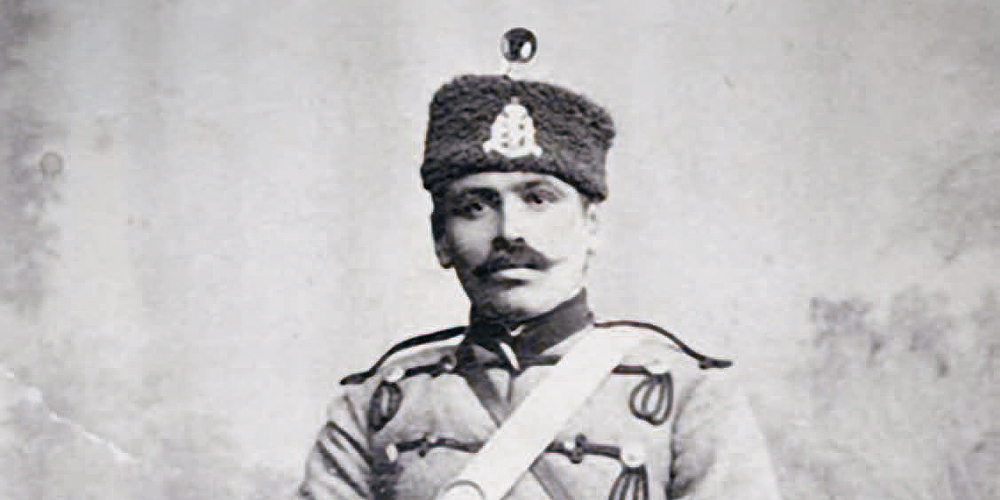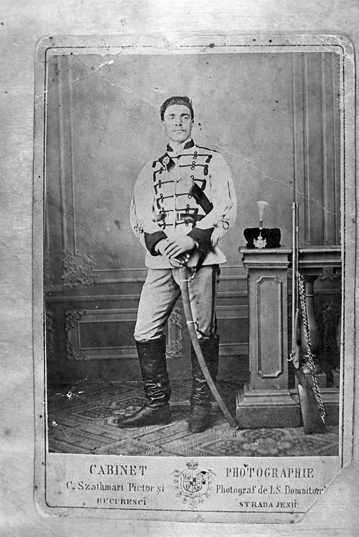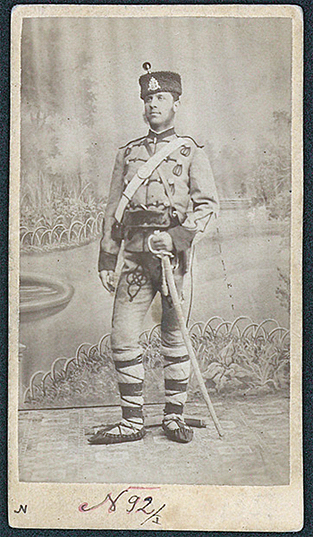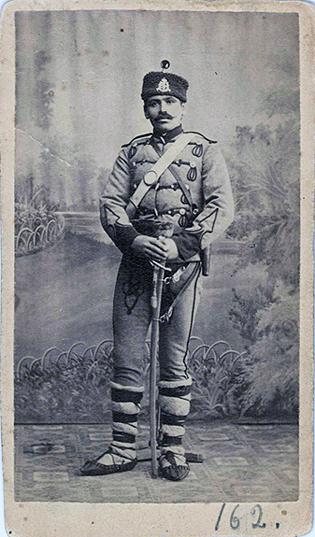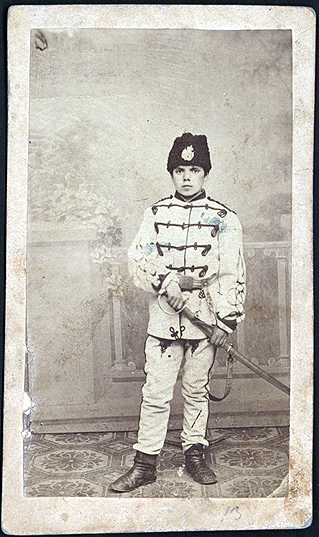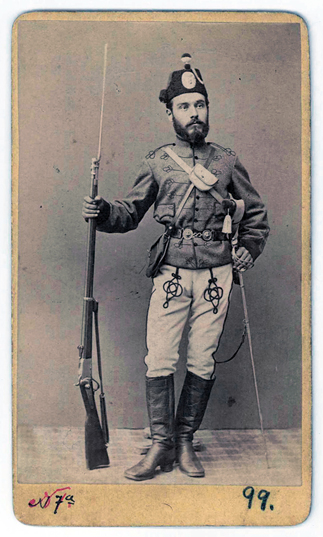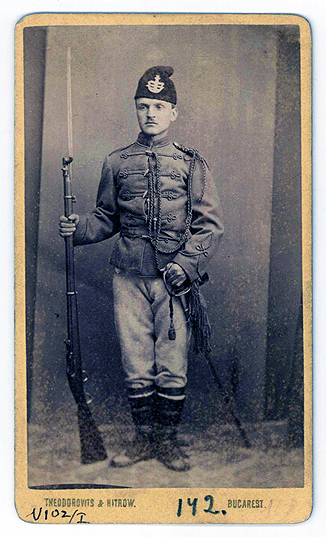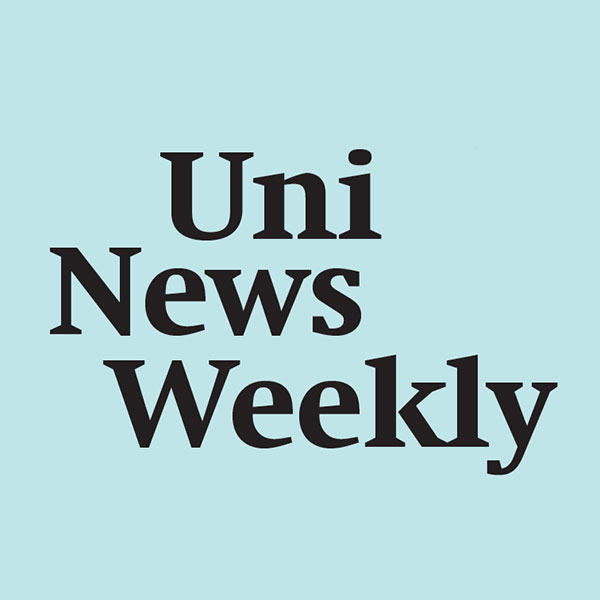National heroes from the photo studio
Till Hein
In her current research project, Martina Baleva is investigating historic carte-de-visite photography – “Facebook of the 19th century.” She has found that, much like today, the “users” were often misled.
They certainly cut dashing figures: Bulgarian “national heroes” in their Hussar uniforms, armed with bayonets or scimitars, looking utterly determined to risk their own lives so that their country could break free from the shackles of foreign rule. Martina Baleva, FAG Assistant Professor of Cultural Topographies of Eastern Europe, knows these portraits from her childhood in Sofi a. “Whenever a parade or rally was held, you would see them on huge posters,” the historian recalls, “they were almost like father figures to me.” To this day, portraits like these hang in schools and public buildings in Bulgaria and illustrate standard works on history. “They’re an integral part of the collective historical tradition,” Baleva explains, “and have been etched into the visual memory of several generations as pictorial testimony to the National Revolution.” Martina Baleva has now begun uncovering the real stories behind the photos.
She explains that the originals of the photos in the “heroes’ gallery” familiar to her since childhood are all carte-de-visite portraits. This kind of photography was once a mass phenomenon of popular culture. A new technique had made it possible to produce whole series of photos quickly and inexpensively. Invented in Paris in the mid 19th century, the new medium soon caught on in many countries.
An instrument of self-presentation
At first, it was only the powerful who had their portraits taken, but their example was soon followed by people from all walks of life, from merchants in Paris to black slaves in the American South and rebel fighters in the Balkans. Calling cards featuring photographic portraits were used to introduce oneself and for networking purposes. They were mailed to influential people or left in their anterooms. They were used for courting and helped to make business contacts and attract sympathizers. “The carte de visite was an analog precursor of today’s social networks,” says Baleva, “Facebook of the 19th century.”
The historian has been studying heroes’ portraits for the past two years and has collected hundreds of them. Reproductions grace the walls of her research room. The pictures date back to the 1860s and 70s. In reality, the men they show were not only from Bulgaria, but from the entire Balkan region, which was part of the Ottoman Empire at the time. Baleva keeps spotting surprising details. For instance, she discovered that one of the men pictured was wearing gaiters over his shoes to give the impression of riding boots. “And look at this,” she says, pointing to one man’s legs, “that uniform looks way too big for him, doesn’t it?” Similarly, close scrutiny reveals that some “national heroes’” jackets are suspiciously tight across the shoulders. “Every- one in the portraits here to the right was wearing the same uniform in the studio,” Baleva explains. “So, what look like snapshots of heroes are really staged photos showing people dressed up.”
As she knows from other sources, the real rebels in the Balkans of the 1860s and 70s fought not in uniforms composed of richly laced jackets and tightfitting pantaloons, but usually in threadbare clothes that were otherwise worn for work in the fields. She has also found out that most of the “national heroes” portrayed were not rebel fighters at all. “When having their picture taken for a carte de visite, law-abiding civilians were fond of posing as they imagined their rebel heroes would.” Baleva calls this a “national revolution in the dark room.”
“This is the real world!”
Baleva’s research on visual historiography, however, extends beyond the 19th century and the Balkan region. She warns that both historic and contemporary photos – whether found in newspapers, magazines or history books – should generally be treated with caution. “Those images have an enormous influence on our attitudes,” she stresses. “They would have us believe that ‘this is the real world’,” she says and smiles, “but most of the time that’s an illusion.” She says that pictures are often staged to arouse emotions and manipulate viewers. “We should be aware that an event and its pictorial representation are inevitably two different things.”
In her classes, she urges students to pose these questions as a matter of routine: How was the image created? Who created it, and for what purpose? What aspects of reality have been excluded? With reference to her ongoing research, she explains that around 1870 the forerunner of Facebook was used by, among others, a few dozen men in the Ottoman Balkans who wanted a revolution: Vasil Levski, one of the main rebel leaders, wrote to local revolutionary committees explicitly demanding that his portrait be distributed, a picture that idealizes him as a courageous revolutionary, dressed as a Hussar officer.
In reality, Baleva says, Levski and his fellow rebels were not exactly glorious figures. “Their actions are better thought of as terror attacks than heroic mass uprisings against foreign rulers.” For instance, the rebels would lay ambush in the hope that the resulting skirmishes would provoke the Ottoman state into a disproportionate retaliation strike which in turn would prompt other superpowers to intervene. Their strategy was ultimately successful. In April 1877, Russia declared war on the Ottoman Empire – and following the Tsarist Empire’s victory, Bulgaria, Romania, Serbia, and Montenegro became politically independent in 1878.
In Bulgaria, however, many a patriotically minded historian felt that reality was not heroic enough. Pointing to the walls of her research room covered in photographs, Baleva says, “To them, the fact that these heroes’ portraits were so homogeneous in style meant a welcome opportunity to create the revisionist fiction of a cohesive military unit fighting for national liberation.” She adds that Bulgarian history textbooks still talk about “people rising up against foreign rule in their thousands,” though in reality there were only a few hundred, as close examination of the historical sources has shown. “It would be wrong to think that photos only reproduce reality; they also create realities,” says Baleva.
Images as a research focus
For this reason, Baleva considers that historical photos should no longer be seen as an “illustrated supplement to historiography – they should be a central component of both historical and contemporary research.” To back up her point, she cites the so-called “iconic turn,” which has been motivating many researchers in the humanities and social sciences since the 1990s. It is an approach that moves away from written sources, with images coming increasingly to the fore.
“It was about time,” Baleva says, adding that it is easy to get lost in the flood of images that we are continually exposed to in the modern world. She says that she is often amazed by how many young people she sees obsessively taking photos with their smartphones. She never takes any herself. In dealing with images of any kind, she takes her time whenever possible, whether she is reading a newspaper, surfing the Internet, studying history books or visiting a museum. “It seems absurd to me to stroll through an exhibition of images as you would through a park,” she says. “Whenever I go to the Kunstmuseum, I only look at one picture each time.”
Finally, Baleva returns once more to the historic carte-de-visite portraits that are the subject of her current research. It was not unusual for the “users” to be misled: The person portrayed would often turn out to be far less good-looking, well-read, brave or competent than their portrait had made them seem, much as on the Internet today. “If you were savvy about using the 19th century equivalent of Facebook,” she says, pointing to the photos on the walls, “then you could conquer hearts, rise to fame or cause political upheaval.”
Even today, a century and a half after they were taken, the “Bulgarian national heroes’” portraits have an influence on life in her home country, says Baleva. Many of the men are shown posing in Hussar uniforms, which originated in Poland and Hungary. “Today, members of the Bulgarian National Guard are proud to wear their Hussar uniforms,” she says, “they’re considered traditional.” In reality, at the time of the “National Revolution,” the only context where these clothes would have been worn in what is now Bulgaria was not in battle, but in a photographic studio.
Martina Baleva is FAG Assistant Professor of Cultural Topographies of Eastern Europe in the 19th and 20th centuries at the University of Basel, a position funded by the Voluntary Academic Society of Basel (FAG).

